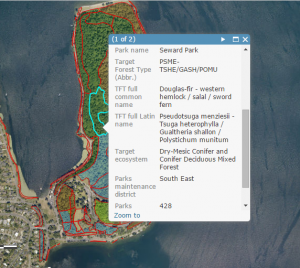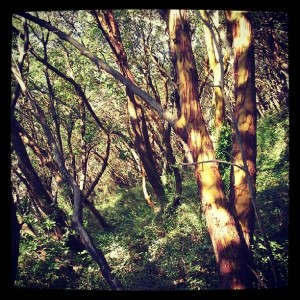Reference Ecosystems
An important principle of restoration is the identification of a reference ecological community to serve as a guide for planning projects and a benchmark for evaluating success. For each of our restoration zones, we have identified two levels to reference based on classifications from efforts to characterize plant communities in the Puget Trough Ecoregion.
A zone’s Target System is a broad classification of the plant community we would like to see in the future. We have identified seven target systems for natural areas in Seattle parks, correspond to NatureServe Ecological Systems and Washington State Natural Heritage Ecological Systems. We measure restoration progress, in part, by comparing data from our ecological inventory to target benchmarks derived from reference characteristics. The seven big elements we look at are: native tree canopy cover, invasive weed cover, a certain number of stems and diversity of new seedlings in the understory, native understory cover and diversity, and invasive tree presence. Below is a table of our target metrics:
| Target Ecosystem Name | Regeneration (trees per acre) |
Regeneration Diversity (# of species) |
Understory Cover (%) |
Understory Diversity (# of species) |
Invasive Regeneration (trees per acre) |
| Conifer Broadleaf Evergreen Mixed Forest | 125 | 3 | 110% | 10 | 10 |
| Dry-Mesic Conifer and Conifer Deciduous Forest | 125 | 3 | 70% | 10 | 10 |
| Mesic-Moist Conifer and Conifer Deciduous Mixed Forest | 200 | 4 | 50% | 14 | 10 |
| Oak Woodland | 50 | 3 | 60% | 12 | 10 |
| Riparian Forest and Shrubland | 125 | 2 | 150% | 14 | 10 |
| Scrub Shrub Wetland | 25 | 2 | 120% | 11 | 10 |
| Bog & Fen | 50 | 2 | 125% | 13 | 10 |
Within a Target System, there are a number of possible plant associations that may occur. We have termed these Target Forest Types (or TFT – and we recognize that not all of them may be forests). A zone’s TFT helps us to select specific species that we may want to include in the planting palette. While it is often the most likely or desirable association we hope to see within a zone, the TFT is relatively flexible, and project managers and Forest Stewards should feel free to experiment with species from a number of TFTs within their Target System. It is not uncommon for a range of different plant associations to occur within a zone.
The TFTs we use are based on associations documented by ecologists in nearby places with similar conditions to Seattle. These associations are named by dominant and diagnostic plant species (The dashes in the names separate species in the same canopy layer; slashes separate species in different canopy layers).
Find your Target Forest Type and Target Ecosystem
To find the target system and TFT for your site, use the GSP Reference Map to pan to the zone that you work in. Left-click on that zone and a window should pop up that lists both the target system and TFT.
The table below shows the target systems and TFTs selected for all GSP restoration zones and the corresponding number of citywide acres.
| Target Systems | Target Forest Types (TFT) | # of acres |
| Bog and Fen | PICO/LEGR/SP shore pine / Labrador tea / sphagnum spp | 6.2 |
| Conifer Broadleaf Evergreen Mixed Forest | PSME-ARME/GASH Douglas-fir- Pacific madrone /salal | 71.7 |
| PSME-ARME/HODI/LOHI Douglas-fir- Pacific madrone / oceaspray / honeysuckle | 101.8 | |
| PSME-ARME/VAOV Douglas-fir- Pacific madrone / evergreen huckleberry | 34.2 | |
| Dry-Mesic Conifer and Conifer Deciduous Mixed Forest | PSME/GASH/POMU Douglas-fir / salal / sword fern | 391.1 |
| PSME-TSHE/GASH/POMU Douglas-fir- western hemlock / salal / sword fern | 570.3 | |
| PSME-TSHE/GASH-MANE Douglas-fir- western hemlock / salal- dwarf Oregon grape | 204.5 | |
| Mesic-Moist Conifer and Conifer Deciduous Mixed Forest | ACMA-ALRU/POMU-TEGR big leaf maple- red alder/ sword fern – fringecup | 33.7 |
| PSME-TSHE/MANE-POMU Douglas-fir- western hemlock/ dwarf Oregon grape/ sword fern | 647.7 | |
| THPL-TSHE/OPHO/POMU western red cedar- western hemlock/ devils club/ sword fern | 106.5 | |
| TSHE-PSME/POMU-DREX western hemlock – Douglas-fir / sword fern – spreading woodfern | 103.7 | |
| Oak Woodland | QUGA-PSME/SYAL/POMU Oregon white oak- Douglas-fir / common snowberry/ sword fern | 24.9 |
| Riparian Forest and Shrubland | ACMA-PSME/ACCI/POMU big leaf maple – Douglas-fir / vine maple / sword fern | 15.2 |
| ACMA-PSME/COCO/HYTE big leaf maple – Douglas-fir / beaked hazelnut / Pacific waterleaf | 30.5 | |
| ACMA-THPL/OECE big leaf maple – western red cedar / Indian plum | 122.0 | |
| ALRU/RUSP/CAOB-LYAM red alder / salmonberry / slough sedge – skunk cabbage | 136.6 | |
| FRLA-POBA/RUSP Oregon ash – black cottonwood / salmonberry | 6.3 | |
| POBA/COSE black cottonwood / red-twig dogwood | 14.8 | |
| POBA/SYAL black cottonwood / snowberry | 13.8 | |
| POBA-ALRU/RUSP black cottonwood – red alder / salmonberry | 22.0 | |
| TSHE-THPL-ACMA/ACCI/LYAM western hemlock – western red cedar – big leaf maple / vine maple / skunk cabbage | 43.7 | |
| Scrub Shrub Wetland | SA/SPDO-COSE-LOIN willow / Douglas spirea – red-twig dogwood – black twinberry | 24.2 |
| SASI/SPDO Sitka willow / Douglas spirea | 27.8 |
*Fact sheets for non-linked associations are pending.
For more information, check out this video from a 2015 training.
Connect with Us
RELATED TOPICS

